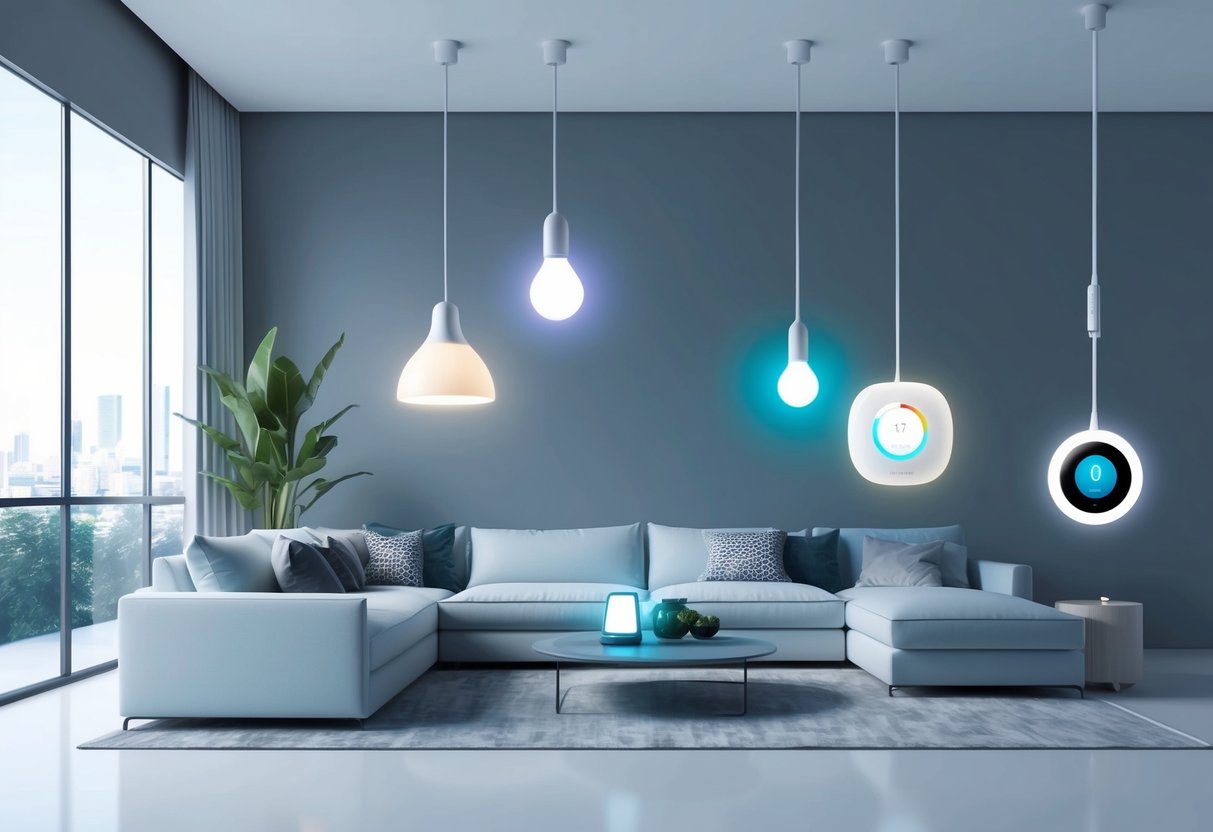
Smart Lighting Solutions
Modern smart lighting enhances convenience, saves energy, and allows for personalized ambiance. Users can control lights with voice commands, mobile apps, or scheduled routines.
Smart Light Bulbs and LED Lights
Smart light bulbs and LED smart bulbs are designed for easy installation and compatibility with platforms like Amazon Alexa and Google Assistant. Homeowners can switch between millions of color choices, set brightness levels, or automate schedules to fit daily routines.
Popular options such as Philips Hue and LIFX offer features like dimming, customizable scenes, and remote access via apps. Energy efficiency is a major advantage, with quality LED smart bulbs using less power than standard bulbs and offering a longer lifespan.
Many budget-friendly options exist, starting at under $10 per bulb, so entry into smart lighting doesn’t require significant investment. Additional features like color temperature adjustments improve comfort by matching lighting to activities from reading to relaxing.
For specific ideas and product options, check out the best smart lights for 2025.
Smart Switches and Dimmers
Smart switches and dimmers give users the power to control non-smart bulbs and hardwired fixtures throughout the home. Installation typically requires wiring into the wall, making them ideal for main living areas, hallways, or outdoor lights.
These devices can often be controlled by apps, voice assistants, or scheduled timers for greater flexibility. A key benefit is the ability to automate lighting for energy efficiency, including turning off lights when rooms are unoccupied or lowering brightness during the day.
Smart dimmers enable adjustable brightness, which saves energy and extends bulb life. Most new models also include compatibility with leading smart home ecosystems, ensuring integration with other connected devices.
Automated Smart Blinds
Automated smart blinds offer both comfort and energy savings by adjusting window coverings throughout the day. Many systems let users schedule blinds to open with sunrise or close at sunset, improving temperature control and privacy.
App and voice controls are standard, letting users respond to changing light without manual adjustments. Some smart blinds connect directly to broader smart home platforms, allowing seamless integration with lighting and climate controls.
Motorized units can reduce heat gain in summer and retain warmth in winter, cutting energy costs. When chosen with care, smart blinds elevate both the functionality and efficiency of any living space while supporting modern automation trends.
Home Security and Safety Technology
Protecting a home with up-to-date technology helps deter break-ins, keeps loved ones safer, and provides peace of mind through real-time alerts and controls. Integration of smart locks, sensors, cameras, and security systems enables effortless management and stronger protection, even on a budget.
Smart Locks for Home Access
Smart locks have quickly become a staple in modern home security. They allow homeowners to lock or unlock doors remotely, set temporary access codes for visitors, and receive notifications of any entry attempts.
Most smart locks support compatibility with popular virtual assistants, making it easy to check lock status with a voice command. Features such as auto-lock, geofencing, and tamper alarms help prevent unauthorized access.
Brands like August, Yale, and Schlage offer models with Wi-Fi or Bluetooth connectivity, while options from Abus are noted for sturdy build quality. Smart locks eliminate the risk of lost keys and allow safer package deliveries by granting controlled entry.
Installation is straightforward and often requires only a screwdriver. Advanced models integrate with broader home security systems for seamless control and central monitoring.
For renters or those on tighter budgets, keypad or retrofit locks offer affordable flexibility.
Home Security Systems and Sensors
Comprehensive home security systems combine motion detectors, door and window sensors, sirens, and often environmental sensors for smoke or water leaks. DIY kits from Ring, SimpliSafe, and Abus are user-friendly and can be monitored via smartphone apps or professional services.
The most effective home security setups provide layered defense, alerting users to activity through instant notifications. Many systems are modular; extra sensors, cameras, or smart alarms can be added as needs change.
Integration with other smart devices, such as lights or locks, creates automated routines that can simulate occupancy. Key considerations include contract requirements, cellular backup, battery life, and compatibility with existing smart home platforms.
Top options like the Ring Alarm Pro rank highly for reliability and expandability. Advanced features such as facial recognition and customizable alert zones further minimize false alarms and improve response accuracy.
Smart Cameras and Video Doorbells
Smart security cameras and video doorbells enable users to monitor entry points, record incidents, and communicate in real time with visitors. These devices stream live HD video to phones or tablets, often with two-way audio and night vision capabilities.
Popular brands such as Arlo, Google Nest, and Ring make models suitable for both indoor and outdoor use. Motion alerts, person detection, and package tracking are standard on higher-end models, making them effective deterrents against theft or vandalism.
Video clips are usually stored in the cloud or on local devices for easy access. Installation can be wireless or wired, depending on preferences and property layout.
Features worth considering include weather resistance, field of view, and integration with existing smart home devices. Combining cameras with video doorbells boosts coverage, especially at entryways and driveways.
Security Measures and Privacy
Balancing strong security with privacy is essential in any smart home setup. Users should activate encryption and password protection for all devices.
Regularly updating firmware and reviewing app permissions can reduce unauthorized access and vulnerabilities. It’s important to choose products with transparent privacy policies and options for disabling or restricting video and audio recording.
Obtaining consent from household members and visitors before recording is courteous and may be required by law in some areas. Physical safeguards such as lockboxes and window reinforcements can complement digital measures.
Cloud-based systems should enable data export or deletion as needed. Responsible placement of smart cameras and awareness of security measures enhances personal privacy while safeguarding the home.